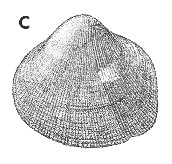
Revised descriptions of New Zealand Cenozoic Mollusca from Beu and Maxwell (1990)

 | Revised descriptions of New Zealand Cenozoic Mollusca from Beu and Maxwell (1990) | 
|
  (Pl. 34c): holotype, GS1325, Y17/f9498, Mangatarehu Stream, 2 km south of Te Karaka, Gisborne, Opoitian (TM4501, GNS) |
Beu & Maxwell (1990): Chapter 14; p. 282; pl. 34 c.
Synonymy: Nemocardium (Pratulum) quinarium Marwick, 1944, p. 266; Beu & Maxwell 1990, p. 282, pl. 34c.
Classification: Cardiidae: Protocardiinae
Description: Very small (11-13 mm high; the smallest New Zealand cardiid), exceedingly thin and fragile, almost equilateral, well inflated, very finely sculptured. Posterior area clearly demarcated (as in all Pratulum species), in this species because of much narrower radial costae on posterior than on median and anterior areas of disc; median and anterior areas sculptured with exceedingly low, fine, yet flat- topped, relatively closely spaced, smooth radial costae, interspaces each about 0.3-0.5 width of 1 costa; 5 costae per mm at 10 mm from umbo; posterior area with high, thin, radial costae but spaced as on remainder of shell, the interspaces crossed by many low, narrow, closely spaced commarginal bars; no tubercles on costae. Ventral margin crenulate. Hinge not observed on available material, but presumably as in P. pulchellum, a typical (if very narrow) cardiid hinge, with very small, central cardinal teeth, and very small lateral teeth and sockets widely separated from cardinal teeth, on the hinge extremities.
Comparison: The younger species Pratulum pulchellum (Pl. 46k; Mangapanian-Recent) is larger (to ca. 30 mm long) than P. quinarium and has coarser sculpture (three radial costae per mm at a height of 10 mm), and has many small, sharp tubercles on the posterior area. P. finlayi (Kapitean-Waipipian) has not been found occurring sympatrically with P. quinarium but occurs in similar environments, perhaps in shallower water; it differs from P. quinarium in its larger size (to ca. 16-18 mm high) and markedly coarser, more widely spaced radial costae (two per mm at a height of 10 mm). The apparently abrupt change from P. quinarium to P. pulchellum is potentially useful for recognising the Waipipian-Mangapanian boundary but in practice is difficult to use, as these small, fragile shells are difficult to collect and prepare.
Distribution: Tongaporutuan ?; Kapitean-Waipipian. Mangatarehu Stream, Waikohu, Gisborne district, Opoitian (type); very common at a large number of localities throughout New Zealand in latest Miocene to mid-Pliocene soft-bottom facies, mainly from rather deep-water (outer shelf or upper bathyal) deposits, at many places occurring as "clumps" in mudstone, with no other macrofauna; probably indicating a soft, fine substrate rather than any particular depth.
Cite this publication as: "A.G. Beu and J.I. Raine (2009). Revised
descriptions of New Zealand Cenozoic Mollusca from Beu and Maxwell (1990). GNS
Science miscellaneous series no. 27."
© GNS Science, 2009
ISBN
978-0-478-19705-1
ISSN 1177-2441
(Included with a PDF facsimile file
copy of New Zealand Geological Survey Paleontological Bulletin 58 in CD version
from: Publications Officer, GNS Science, P.O. Box 30368 Lower Hutt, New
Zealand)